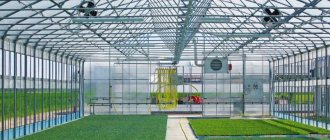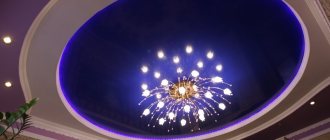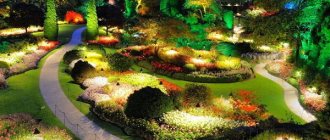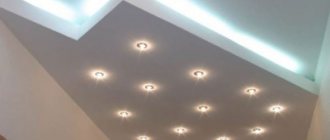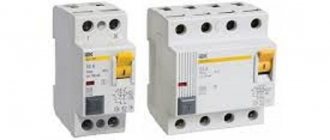Installing street lighting in a summer cottage or in the courtyard of a private house is a very important task that requires a comprehensive solution. Unlike an apartment in a multi-storey building, the situation outside of which is not entirely of interest to the owner, owners of their own houses need to control the area around it. And it’s much better to take a walk in the fresh air in the evening along the illuminated paths of your yard.
At first glance, installing a street lighting system for the courtyard of a house seems simple. However, for the entire complex of equipment to operate normally, it must be correctly selected and installed. Read on to learn how to make lighting in your garden plot.
Types of courtyard lighting in a private house
Lighting in a summer cottage or garden plot performs three functions:
- Technical. It consists of illuminating the area to ensure safety of movement around the area in the dark. For this purpose, buy regular halogen or LED lights. They are placed along the paths.
- Decorative. Such lighting is part of the landscape design and serves to highlight with the help of light all the beauty of the flora of the garden plot. Especially often, many owners highlight alpine slides, mini-pools, and flower beds. To provide decorative lighting, colored lanterns of a wide palette are used. To make the picture pleasing to the eye, some decorative lighting systems are controlled by special computers that create real color shows. However, it is worth noting that they are quite expensive and should only be installed by specialists.
- Security feature. An illuminated garden plot does not attract petty thieves, who are constantly trying to steal from the yard everything that is “badly lying”. Even if the owners are not at home, the illuminated area will make thieves wonder whether it’s worth going there. Sometimes lighting with motion sensors works better than a security alarm.
How do they light the street?
Issues of light in the evening and at night are resolved by installing street lamps, floodlights or lanterns. These methods of courtyard lighting are used depending on their destination.
When designing a beautiful landscape, you can’t do without lamps to illuminate your yards. These elements on the street will change the appearance of the land beyond recognition. Skillfully selected in the same style, they will create an atmosphere of comfort in the garden under the night sky after working days.
The simplest solution is to place the lamps along the garden paths, but this arrangement is applicable for small pieces of space. For more practical illumination, lamps are installed in the form of small floor lamps with frosted glass.
Lamps in the form of polycarbonate balls fit perfectly into the design. Dim lamps inside create diffused light in the middle of a lawn or colorful flower bed.
From the point of view of practicality and economy, the use of solar-powered devices can be successful. They are charged during the day from the sun's rays; they do not need to be connected to the electrical network.
They also have built-in sensors, and the LEDs automatically emit light as it gets darker outside. By moving these lamps in the garden, you can radically change (according to your mood) the appearance of the area.
The use of various lanterns will also help illuminate the building and the surrounding area in the most interesting styles - English, oriental, French, classical or modern high-tech.
To achieve a targeted light flow, landscape designers use floodlights to illuminate the yard. These devices are distinguished by the type of light source: metal halide, LED, halogen or sodium lamps. It is important that the spotlights are reliably protected from street moisture and dust.
Planning lighting for a private yard
No installation of a lighting system is possible without detailed planning. Ideally, a plan should be drawn up for the placement of light sources, indicating their type, connection features, types and sizes of wires, placement of poles, etc. Thanks to this planning, installing lighting on a personal plot will be much easier.
The main place where mandatory installation of lighting fixtures is necessary is the porch of the house and its gate (gate). At night, the owner of the estate must control everything that happens at his gate. As a rule, lamps that illuminate the area in front of the gate are equipped with motion sensors. In this case, the light will turn on when a person approaches the gate. This is very convenient and also allows you to significantly save energy. Typically, LED spotlights are used as a lighting device for such cases, which have excellent light output with low power consumption. Another undeniable advantage of LED lights is their long service life compared to other types of lighting devices.
If there are recreational areas on the site (barbecue area, children's playground, bathhouse with adjacent territory), both it and the paths that lead to it are highlighted. For ease of parking at night, the parking area should be illuminated.
When planning the entire lighting system, it is necessary to clearly understand how they will be connected by electrical cable. The cable can be laid along an overhead line between lighting poles or through an underground tunnel. Each method has its own advantages and disadvantages.
Installing an overhead line is much simpler and cheaper. However, for this operation it is necessary to buy a special cable that will not be subject to stretching under the influence of wind. Also, to hang it, you need to use a special wire that will hold it in the canopy. In addition, during strong hurricanes, there is a high probability of the cable breaking due to strong winds.
When the cable is located underground, it can last for several decades, because external forces do not act on it. True, the cable laid in the trench must be hidden in a metal sleeve, which adds costs to the overall estimate.
Lighting functions and requirements for it
Before selecting equipment and planning its location on the site, it is worth considering what functions it should perform. There are options here:
- Technical lighting. It has a utilitarian purpose and should provide good visibility wherever necessary. First of all, this concerns the entrance area of the house, the parking area, and the place near the entrance gate. It is also worth well lighting gazebos, playgrounds, paths near ponds and other dangerous objects.
- Decorative lighting. With its help, you can create a comfortable atmosphere for relaxation in the area; most often, soft, diffused light is used. Both traditional lamps and special lighting are used, which can highlight plants, flower beds, alpine slides, ponds, improvised fountains, etc. LED strip or special garlands for street lighting can also be used here.
- Protection from thieves. Attackers are unlikely to climb into a well-lit area that can be seen far away. And to further increase security, you can connect motion sensors that will be triggered when someone walks through the yard. They are excellent at scaring away uninvited guests.
Lighting can serve both practical and decorative purposes at the same time.
The lighting system can perform both one and several tasks. It all depends on the characteristics of the site and the equipment used.
Before choosing, you need to make sure whether it meets the basic requirements:
- Ergonomics. The light should provide a comfortable environment, not hit the eyes and not force one to peer. It is important to think in advance about how best to zone the space and which areas need to be highlighted the most. When planning façade lighting, choose models that will not shine inside the windows and interfere with your relaxation.
- Compliance with the general design of the plot. Select types of lamps that will fit into the overall environment and look good. For an elaborate design, strict equipment is suitable, but for a yard in a minimalist style it is better to buy unusual models. You can combine lighting with decoration and purchase figurines with built-in lights.
- Economical consumption of electricity. Installing a backlight that is constantly on even if there is no one on the site is not the best solution. In this case, you need to use motion sensors or manual activation so that the light only works when required. It is also very important to choose lamps with energy-efficient light bulbs, due to this you can reduce the electricity consumption for lighting the area several times.
- Easy to maintain and safe system. It is worth using equipment specifically designed for open air and having a long service life. If the lamps are replaceable, they should be easy to change if necessary.
LEDs provide spectacular light while consuming very little electricity.
Models with protection from dust and moisture are selected. The packaging or instructions should indicate that the lamps can be installed outdoors.
Installing lighting poles in a private yard
If there are natural supports for installing lighting fixtures, the task of installing the entire system is greatly simplified. The wall of any building or its roof, etc. can serve as a natural support. For objective reasons, it is undesirable to use tree trunks.
If there are no supports, you must build them yourself. Lighting poles are made from hollow steel pipes and installed on a concrete foundation. To equip it, holes are dug 0.4x0.4 m in size and 0.5 m deep. A layer of sand or crushed stone is laid on its bottom, and formwork is installed. A hole is made in the formwork through which the corrugation is inserted. It is taken upstairs to lay the flashlight connection cable along it. Next, several pieces of reinforcement or thick wire are installed inside the formwork as a reinforcing belt. Then anchor bolts are installed inside the formwork, to which the pole will be screwed. After this, the formwork is filled with concrete. Concrete is prepared using a cement-sand mixture in a ratio of 1 part cement to 3 parts sand. When the places for installing the pillars are ready, the pillars are installed in a vertical position with mandatory leveling. The adjustment is made using metal spacers.
The wires are laid in a trench with a depth of at least 0.7 m. The distance from the power cable to the nearest building must be at least 0.5 m. The bottom of the trench is filled with sand or screenings. The cable is placed in a protective metal sleeve. After the cable is laid, the entire system is connected. The lantern wiring is connected to the main cable using special terminals. Twisting of wires in this case is unacceptable.
When installing a courtyard lighting system, special attention must be paid to the choice of power cable. It must have a safety margin of at least 25% of the current consumed by all lighting fixtures. For example, if all the lamps in the system operate at a current of 10A, that is, they consume approximately 2 kW, then the wiring should be designed for a current of 13-14A. If you plan to install additional light sources on the site, then it is better to lay the route with a reserve. It is better to choose a cable that is double insulated, so it will be better protected. An aluminum cable is quite suitable for such work; it costs much less than its copper counterparts.
The entire lighting system is assembled on one panel, on which automatic switches are installed to turn off each branch. It is better to make lighting from several branches, as this will make it possible to turn off only one of them for repairs.
Choosing lamps for landscape lighting
“Lamps used in landscape lighting should be attractive and proportional to the space being designed.”
What is important in this matter? First of all, design features. For example, small architectural forms require delicate, very soft lighting, which will never be provided by powerful spotlights, appropriate for depicting tall trees
Very soft lighting is suitable for buildings
A special approach is also needed to the lighting design of paths. The principle of direct proportionality applies here. The wider the alley, the more powerful lighting it will need. Failure to follow the recommendations and inadequate selection of lamps will lead to the fact that the light supplied by them will either dazzle or leave shadowed areas. In both options, moving along the paths will be uncomfortable and dangerous. In landscape design, garden paths are usually highlighted with columnar lamps of appropriate height for the situation.
Pathways require more powerful lighting
Lighting fixtures used in landscape lighting should be attractive and proportional to the space being designed. Their task is to look harmonious on the site during the daytime, becoming small decorative forms for the landscape during this period. To do this, the supports of the structures must be the product of lightness and grace, only in this way can they be painlessly integrated into the natural landscape.
All lamps must fit harmoniously into the landscape
Choosing yard lighting fixtures
Currently, the choice of outdoor lighting devices is very large, which makes it possible to assemble a system to suit your requirements. All lamps are divided into several groups. Basically, the division occurs depending on the lamp that is used in it.
- Halogen lamps. The glow of halogen lamps occurs due to the passage of electric current through a flask with vapors of substances - halogens, such as iodine, bromine, fluorine, etc. Such lamps are not too sensitive to voltage fluctuations and harsh operating conditions. Therefore, their service life is much longer compared to incandescent lamps. They are also much more efficient than “Ilyich bulbs”, since with the same light output they consume much less electricity. Such lamps are not too expensive.
- Sodium. The principle of operation of such lamps is almost identical to halogen lamps. Sodium vapor glows in the bulb of such a lamp. Their glow has a warm, gentle tint, which allows them to be used to create various lighting effects. Another positive aspect in the operation of sodium lamps is their service life, which reaches 30 thousand hours.
- LED bulbs. The most modern types of lighting devices. They are characterized by low energy consumption, long service life, and low sensitivity to voltage changes. LED lamps can be built on the basis of one extremely bright LED or a large number of lower power parts. Since the LED lamp is a high-tech product that has a special voltage controller, the prices for these products are still quite high. However, it is worth noting that they are decreasing every year.
Yard Lighting Planning
Without a clear plan, you should not make light in the yard, as you will inevitably have to redo something or make changes. In addition, without preparation it is impossible to buy everything you need. Therefore, you need to follow simple instructions:
- Consider the location and type of lamps that will be used. First, just walk around the site and make a list indicating all the equipment and the location of its installation.
- Draw a diagram of the site. You can copy it from the project, or you can simply mark the boundaries of the yard and the location of all buildings, paths and other objects on a piece of paper.
- Determine where the cable connection will be and how best to remove it from the house. Most often they are connected to the distribution panel, and a separate circuit breaker is placed on the street light so that, if necessary, it can be turned off during repairs and maintenance.
- Mark all the lamps on the plan. Calculate how much cable and other components you will need, always leave a small margin, since the actual consumption is most often greater than planned.
- Buy everything you need for work. Also, don’t forget about the tools you will need.
An example of a finished plan indicating all the lighting features of the site.
If a cable is to be laid, then all lines must be included in the project.
What type of lamps is better to choose
To provide good light and reduce electricity consumption to a minimum, you need to choose the optimal type of lamps. There are several main options:
- Incandescent lamps should not be installed in street lamps. Although they are cheap, they do not last long, get very hot during operation and do not provide the required light intensity.
- Halogen lamps are much better in terms of light quality, but they are also not durable. They get very hot and consume a lot of electricity.
- Luminescent options are much better in terms of energy consumption than the first two types. They provide good light, but do not tolerate temperature and humidity changes well, so you need to install them in sealed shades.
- LED lamps are the most economical today. The service life is 50,000 hours, which is much longer than any other analogue. You can select the color temperature and adjust the brightness.
LED lamps provide even, flicker-free light and last a very long time.
LED systems can be set to dim the lighting during periods when everyone is sleeping to further save electricity.
Tips for choosing street lighting from the portal forumhouse.ru
Autonomous lamps for lighting the courtyard of a private house
Many owners of areas where frequent outages occur prefer to assemble an external lighting system based on autonomous lamps. The principle of their operation is to be powered by a rechargeable battery installed inside. The latter is charged during daylight hours from a solar cell.
Advantages of autonomous lamps:
- Mobility. Since there is no need for wiring when installing stand-alone luminaires, they can be installed and dismantled in a short time. This allows you to remove the system from the dacha plot for the winter if the dacha is not in use.
- Low costs for installation work. Some lamps just need to be stuck into the ground, and they will work at the right time. There is no need for electrical installation or excavation work.
- Low power consumption. Basically, autonomous lamps are built on the basis of LED lamps, which allows reducing energy consumption several times.
Main types of lighting for local areas
Lighting is made according to the developed project
The range of street lighting market is very rich and divided into groups. The separation helps to clearly understand what the lighting device is used for. There are three main types of lighting:
- Decorative – used to highlight decorative elements, shrubs and trees, and adjacent areas. Can be made in different colors;
- Technical lighting – used to illuminate the main entrance, doors, garage doors.
- Accompanying is the backlight, which is turned on thanks to sensors and helps illuminate the path when moving to the desired area.
Outdoor gazebo lighting option.
To make it clearer and easier for you to decide, next we will look at planning lighting in certain areas. After considering the options for supplying light to the site, it will be much easier for you to draw up a project for future lighting and purchase the necessary equipment.
How to make outdoor lighting yourself
To install outdoor lighting yourself, you will need three large groups of devices:
- Lighting devices . Lamps, lanterns and so on.
- Control technology . Equipment for control and automation of street lighting. For example, setting parameters so that the lighting turns on at a certain time of day or even on a specific day.
- Communications . This group includes various cables, pipes, terminals, ties and other things used during installation.
Installation stages
The lighting installation work consists of several large-scale stages.
Design
If your home has a swimming pool or an outdoor staircase, then such lighting will look very elegant.
The first step is to create a plan and divide all lighting devices into groups, for example, devices for lighting paths in the garden into one, and facade lighting into another.
Preparation
After this, the stage of selecting places for the devices begins, holes are dug in them. They will serve as formwork for the subsequent pouring of the foundation. All holes must be connected with shallow (about 400 mm) trenches . Then, from the outer hole for the lamp, a trench is laid to the house to lead the wires into the electrical panel.
You will find all the information about LED street lights on poles here.
Laying communications
The next step is to lay the electrical cables. A layer of sand is poured into the trench and a wire wrapped in a special metal sleeve is laid. Each group of devices must be connected with a separate cable. All cables must be covered with a 100 mm layer of sand and laid on top with bricks in one layer.
Instead of brick, you can use crushed stone, which will also help protect the cables from mechanical damage.
Where the lamps will be installed, it is necessary to loop the wires outward. Then fill the hole with concrete and fill the ditches with dug earth.
Installation of the devices themselves
First you need to disassemble the lighting device: separate the lamp from the installation element. Then fold the cable into a loop and cut it, strip the ends and thread it through the installation element.
Next, the heel is attached to the foundation: holes are drilled in the concrete and the heel is nailed using dowels (or anchor screws, depending on the weight of the lighting devices).
After installing the installation element, you need to connect the lamp to the wiring and install it on the heel.
Important: do not forget about grounding. If there is no grounding, there is a high chance of electric shock and failure of lighting fixtures. Therefore, all street wires must be laid with a three-core cable.
Lighting automation
In its simplest form, lighting automation is the collaboration of presence sensors to turn on lights and motion sensors. When installing a control system, it is necessary to install an individual sensor for each group of lighting fixtures.
This system allows you to turn on only certain groups of devices. For example, only emergency lighting. This will significantly save money.




